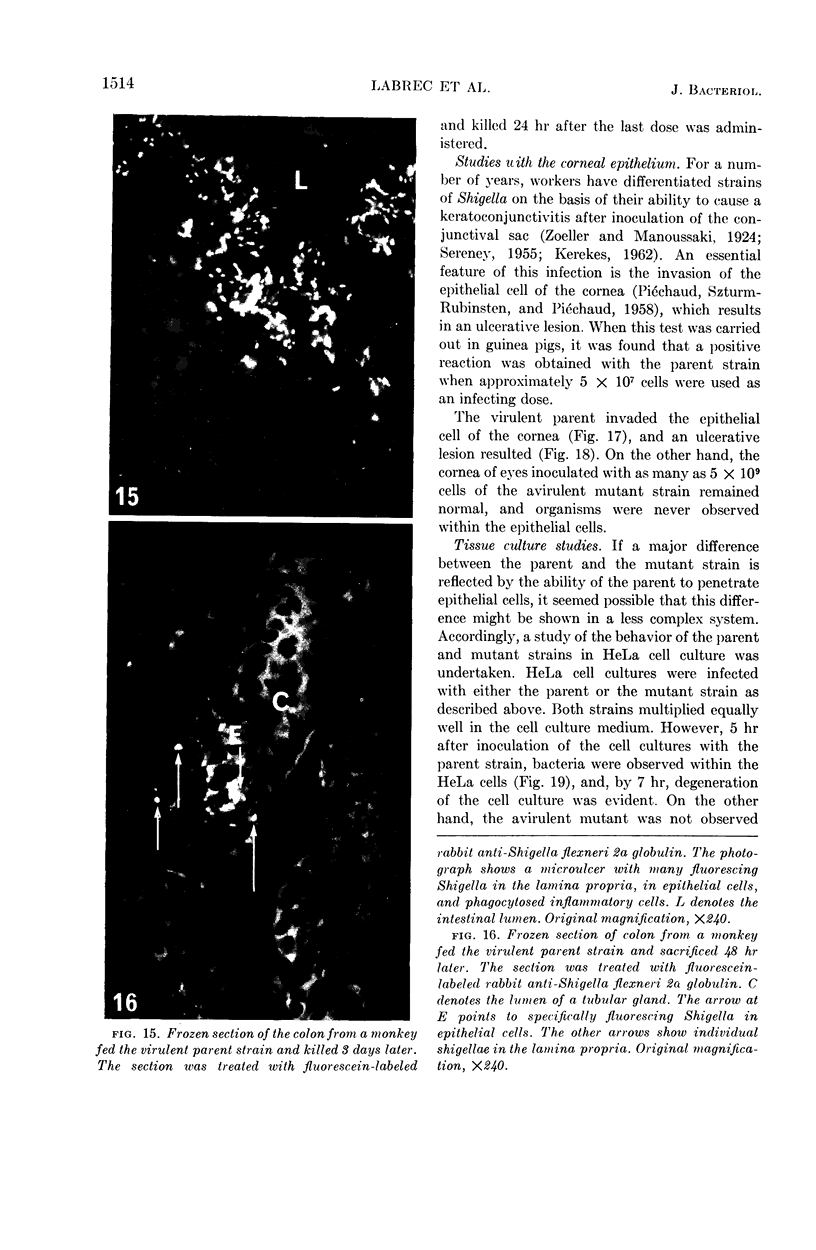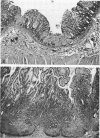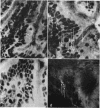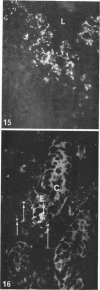Abstract
LaBrec, Eugene H., Herman Schneider, Thomas J. Magnani, and Samuel B. Formal. Epithelial cell penetration as an essential step in the pathogenesis of bacillary dysentery. J. Bacteriol. 88:1503–1518. 1964.—A parent strain of Shigella flexneri 2a and a colonial mutant derived from it were studied in three animal models. Both strains were equally virulent for mice when living cells suspended in hog gastric mucin were injected by the intraperitoneal route. Feeding the parent strain to starved guinea pigs, followed by the intraperitoneal injection of opium, resulted in the formation of ulcerative lesions in the intestinal tract and in the death of these animals. When the colonial variant was fed to similarly prepared animals, the animals survived and the intestinal tract remained normal. The parent produced diarrheal symptoms and intestinal lesions after its oral administration to rhesus monkeys; the variant caused neither symptoms nor pathology in this species. Studies were carried out to define the characteristics present in the parent strain and absent in the colonial mutant, which would enable the parent to produce ulcerative lesions of the bowel and death in the guinea pig model or intestinal lesions and diarrheal symptoms in the monkey. Neither serological studies nor growth studies conducted both in vitro and in vivo offered a clue to explain this difference. The virulent parent strain was shown to penetrate the bowel epithelium and enter the lamina propria; the avirulent mutant did not do this. Entrance to the lamina propria was by way of the epithelial cell of the mucosa. The avirulent mutant did not possess the capacity to penetrate this cell. This observation was extended to show that the virulent parent possesses the ability to infect and multiply within HeLa cells; furthermore, the organisms are able to penetrate epithelial cells of the guinea pig cornea, causing ulcerative lesions. The avirulent variant possesses neither of these capacities. It is suggested that epithelial cell penetration is a major factor in determining the pathogenicity of dysentery bacilli.
Full text
PDF















Images in this article
Selected References
These references are in PubMed. This may not be the complete list of references from this article.
- COOPER M. L., KELLER H. M., WALTERS E. W. Microscopic characteristics of colonies of Shigella flexneri 2a and 2b and their relation to antigenic composition, mouse virulence and immunogenicity. J Immunol. 1957 Mar;78(3):160–171. [PubMed] [Google Scholar]
- DIXON J. M. The fate of bacteria in the small intestine. J Pathol Bacteriol. 1960 Jan;79:131–140. doi: 10.1002/path.1700790116. [DOI] [PubMed] [Google Scholar]
- FORMAL S. B., ABRAMS G. D., SCHNEIDER H., SPRINZ H. Experimental Shigella infections. VI. Role of the small intestine in an experimental infection in guinea pigs. J Bacteriol. 1963 Jan;85:119–125. doi: 10.1128/jb.85.1.119-125.1963. [DOI] [PMC free article] [PubMed] [Google Scholar]
- FORMAL S. B., DAMMIN G. J., LABREC E. H., SCHNEIDER H. Experimental Shigella infections: characteristics of a fatal infection produced in guinea pigs. J Bacteriol. 1958 May;75(5):604–610. doi: 10.1128/jb.75.5.604-610.1958. [DOI] [PMC free article] [PubMed] [Google Scholar]
- Falkow S., Rownd R., Baron L. S. GENETIC HOMOLOGY BETWEEN ESCHERICHIA COLI K-12 AND SALMONELLA. J Bacteriol. 1962 Dec;84(6):1303–1312. doi: 10.1128/jb.84.6.1303-1312.1962. [DOI] [PMC free article] [PubMed] [Google Scholar]
- GILBERT R. P. Mechanisms of the hemodynamic effects of endotoxin. Physiol Rev. 1960 Apr;40:245–279. doi: 10.1152/physrev.1960.40.2.245. [DOI] [PubMed] [Google Scholar]
- KEREKES L. Colonial variants of Shigella flexneri. Acta Microbiol Acad Sci Hung. 1962;9:123–132. [PubMed] [Google Scholar]
- LABREC E. H., FORMAL S. B. Experimental Shigella infections. IV. Fluorescent antibody studies of an infection in guinea pigs. J Immunol. 1961 Nov;87:562–572. [PubMed] [Google Scholar]
- LANDY M. The visual identification of V and W form colonies in Salmonella cultures. Public Health Rep. 1950 Jul 28;65(30):950–951. [PubMed] [Google Scholar]
- PIECHAUD M., SZTURM-RUBINSTEN S., PIECHAUD D. Evolution histologique de la kérato-conjonctivite à bacilles dysentériques du cobaye. Ann Inst Pasteur (Paris) 1958 Mar;94(3):298–309. [PubMed] [Google Scholar]
- SCHUR P. H., BECKER E. L. Complement-fixing properties of pepsin-treated rabbit and sheep antibodies. Science. 1963 Jul 26;141(3578):360–362. doi: 10.1126/science.141.3578.360. [DOI] [PubMed] [Google Scholar]
- SERENY B. Experimental shigella keratoconjunctivitis; a preliminary report. Acta Microbiol Acad Sci Hung. 1955;2(3):293–296. [PubMed] [Google Scholar]
- THOMAS L. The physiological disturbances produced by endotoxins. Annu Rev Physiol. 1954;16:467–490. doi: 10.1146/annurev.ph.16.030154.002343. [DOI] [PubMed] [Google Scholar]
- WATKINS H. M. Some attributes of virulence in Shigella. Ann N Y Acad Sci. 1960 Nov 21;88:1167–1186. doi: 10.1111/j.1749-6632.1960.tb20107.x. [DOI] [PubMed] [Google Scholar]












